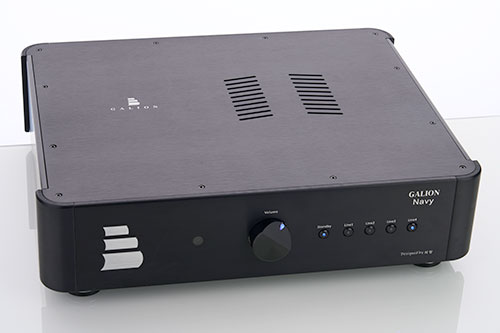
 |
|Ideon Audio 3R USB Renaissance mk2 Black Star, 3R Master Time Black Star, Absolute Time and Absolute Time Signature

But there's more: The Absolute Time comes with a housing milled from a block of aluminum and the toroidal transformer for the power supply is much larger. The rectification is carried out with an active bridge rectifier circuit, which completely dispenses with the usual diodes and is thus intended to largely eliminate diode-rectifier noise. The filter capacities are much more generous and the ELNA Silmic II types with low ESR values, which are well reputed in audiophile circles, are used as filtering capacitors throughout. On the USB input, we also find a proprietary three-stage noise reduction circuit. For the clock oscillator, a much higher quality specimen is used. In addition, the Absolute Time features a fully separated S/PDIF branch with a standalone ultra-low-noise, jitter-free re-clocking platform and a 12 megahertz master clock output for external digital signal sources. This is also intended to help owners of CD players to achieve optimized performance. There is no signal conversion between USB and S/PDIF; so it is not possible to enter the re-clocker via USB and go out again via S/PDIF. The modules for the USB and S/PDIF branch are pluggable, so that upgrades at a later date should be possible without any problems.

And if the ratio of effort and benefit no longer plays a role, then you end up with the top model Absolute Time Signature. Here, two complete Absolute Time USB modules are cascaded. At the same time, the effort for the power supply is taken to the extreme: two toroidal transformers, almost doubling the filtering capacities and in the second stage of voltage stabilization, one of the already lowest-noise voltage regulators available is used in a parallel configuration to reduce the noise even further. The whole thing is packaged in a 22 kilogram (!) case that is twice as deep as the Absolute Time, which makes the Absolute Time look like its smaller brother. For the listening test, I choose a notebook that runs an installation of Windows Server 2019 optimized with AudiophileOptimizer 3.0 and uses JRiver 24 as a media player. There are no other tuning measures, except that I always run the notebook on battery power when listening to music. From the USB output of the notebook it goes to one of the Ideon Re-Clocker models and from there to my PS Audio DirectStream DAC.

-
Galion Audio Navy Röhrenvorverstärker
Wir haben das röhrenbestückte Vorverstärker-Flaggschiff Navy des jungen kanadischen HiFi-Unternehmens Galion Audio unter die Lupe genommen. Der Line-Vorverstärker mit vier Doppeltrioden 12AT7 (ECC81) wartet nicht nur mit hochwertigen Bauteilen auf, sondern er ist das spannende Designprodukt eines high-fidelen Überzeugungstäters. Mir sagte der Markenname Galion Audio bislang wirklich gar nichts. Das junge Unternehmen aus Québec in Kanada wurde 2020 von Thomas Tan, einem passionierten Audiophilen, YouTuber („Thomas & Stereo“) und Content Creator, gegründet. Ziel war, seine…16.12.2025 -
Eversolo DAC-Z10
Meine beiden D/A-Wandler, der DAVE im Arbeits- und der HUGO TT2 im Wohnzimmer, werden serienmäßig von Schaltnetzteilen gespeist. Bei letzterem kommt seit einiger Zeit ein Ferrum Hypsos, bei Chord Electronics Topmodell ein lineares Dreifach-Netzteil zum Einsatz. Ein solches versorgt auch den Eversolo DAC-Z10 – zum Preis von 2.000 Euro. Und nein, es sind keine drei ausgelagerten Stromversorgungen, für die der genannte Preis gilt. Dafür bekommt man das vollständige Topmodell unter Eversolos DACs. Es ist schon…09.12.2025 -
Raidho X2.6 Standlautsprecher
Mit Lautsprechern von Raidho haben wir uns bei Hifistatement schon öfter beschäftigt. Im Fokus standen dabei die Kompaktlautsprecher TD1.2 aus der TD-Serie sowie X1t und X1.6. aus der X-Serie. Diesmal haben wir den Standlautsprecher X2.6 zu Gast, das aktuell größte Modell der X-Serie. Raidho verspricht, mit der X-Serie besonders viel Leistung – sprich Klangqualität – für den aufgerufenen Preis zu bieten. Wobei, „billige“ Lautsprecher – ganz gleich nach welchem Maßstab - hat Raidho noch nie…02.12.2025 -
Canor Virtus A3
Zur diesjährigen HighEnd stellte Canor den Virtus A3 Hybrid-Vollverstärker vor. Der lockt mit einem integrierten Digital-Analog-Wandler und einer diskret aufgebauten Phono-Vorstufe für MM- und MC-Tonabnehmer. Sowohl seine Technik als auch die Ausstattung bieten Ungewöhnliches. Vor allem aber soll er klanglich beeindrucken. Das slowakische Entwickler-Team konnte mich bereits vor einem Jahr überzeugen: Der Vollverstärker Virtus I2 aus der Premium Line musizierte in meinem Hörraum wie keiner zuvor in dieser Preisklasse. Der war ein gestandener Röhren-Vollverstärker. Auch…28.11.2025 -
Dan D’Agostino Progression S350
Dan D’Agostino ist eine Legende im Verstärkerbau. Er folgte wohl nie einer Mode, sondern vertraut bei allen Entwicklungen seinem Gehör und seiner Leidenschaft für den guten Klang. Mehr als 50 Jahre baut er nun schon Verstärker, immer mit dem Ziel, das „Wesen der Musik hörbar zu machen“. Erfüllt auch der S350 diese hoch gesteckten Ambitionen? Die Progression S350 ist die kleinste Stereoendstufe im Gesamtprogramm. Optisch trägt sie alle charakteristischen Merkmale einer echten D’Agostino. Angefangen mit…25.11.2025 -
iFi Silent Power USB iPurifier Pro & Pulsar USB
Ohne iFis iDefender+ würde das PC-Audio-Setup in meinem Arbeitszimmer überhaupt nicht störungsfrei funktionieren. Dementsprechend ist es für mich eines der besten Tools im Bereich Computer-Audio. Der iPurifier Pro vereint seine Fähigkeiten mit denen eines iSilencer+ und noch mehr Features in einem Gehäuse. Außerdem teste ich das Pulsar USB-Kabel. iFi ist seit Jahren eine Konstante für hochqualitative Audio-Produkte zu fairen Preisen. Zuletzt wurde die Sparte für Stromversorgung, Kabel und Signal-Verbesserer unter SilentPower zusammengefasst. Noch bevor wir…21.11.2025
© 2025 | HIFISTATEMENT | netmagazine | Alle Rechte vorbehalten | Impressum | Datenschutz










































































































